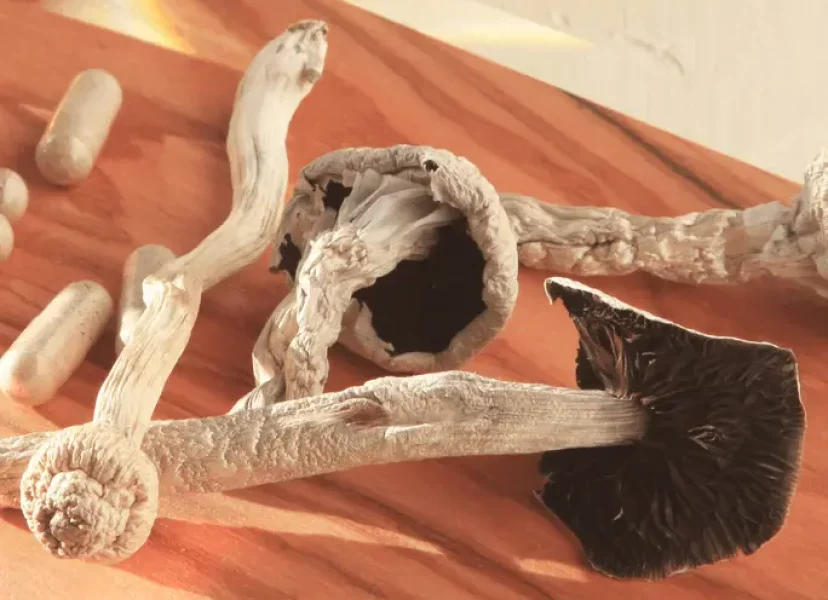As more and more research on psychedelic drugs has come to light over the years, we now know that psychedelic medicine offers an extensive list of benefits and can aid in recovering from various mental disorders and trauma. This begs the question: How often should you be taking psychedelic drugs?
The answer to this question will undoubtedly vary from person to person, however there are a few things to keep in mind when deciding to embark on your next psychedelic experience, such as the type of psychedelic you plan to take and the intentions you have for the experience.
Before diving into the different types of psychedelic drug doses and their effects, it should be noted that while psychedelics possess immense benefits, they are often incompatible with antidepressants and selective serotonin reuptake inhibitors, or SSRIs, as they’ve been shown to weaken hallucinogenic effects.
It should also be noted that people who have a family history of schizophrenia or bipolar are at a much higher risk for having unwanted and potentially harmful side effects, or bad trips, from taking psychedelics.
While there is no concrete minimum age to begin taking psychedelic drugs, it’s probably best for most people to wait until they are at least 25 years old when the brain is fully developed. If none of those risk factors apply to you, keep reading to better understand best practices when it comes to frequency of psychedelic use.
How Often Should You Microdose?
Microdosing is the process of taking a very small amount of a psychedelic substance– one that doesn’t elicit any hallucinations or mind altering effects. These small doses are taken at regular intervals in order to promote productivity, creativity, and increase feelings of overall happiness and well being.
It’s similar to taking weekly supplements, but with more mindfulness-related long term effects. The “standard” amount of a psychedelic drug that’s used to microdose changes based on which substance you choose to take. For example, the typical dosage for microdosing with magic mushrooms is around 0.5-1.5 grams of dried mushrooms.
Meanwhile, for LSD the typical microdose is around 25 micrograms. Many, including us, prefer to microdose psychedelic mushrooms instead of LSD. This is because LSD requires such a minuscule dosage to produce hallucinogenic effects, that it can be harder to regulate dosage sizes, increasing the potential for an uncomfortable experience.
Another benefit of microdosing is that it can be done in almost any circumstance due to the low dosage and minimal effects. Many people use microdosing in order to be more productive at work and feel more attentive.
Because of the small amount and the less profound effects that microdosing has on an individual, most people are able to take psychedelic drugs more frequently when they microdose than when they have a larger dose.
However, since your tolerance increases significantly after taking even the smallest dose of hallucinogenic drugs, it’s best to incorporate a few transition days where you’re not microdosing. This gives you the space and time to integrate the small, but ever-present perspective offered by your microdosing experience.
Microdosing protocols vary, but the most supported one– The Fadiman Protocol, calls for one day on and two days off. This means that if you microdose on Monday, you’ll take a break on Tuesday and Wednesday. On Thursday you’ll take another microdose, take a break on Friday and Saturday, then dose again on Sunday.
Another protocol is called The Stamet’s Stack– coined by amateur mycologist, Paul Stamets. The protocol involves taking a microdose on Day 1-4, using days 5-7 as transition days, microdosing on day 8-11, and taking a break on days 12-14.
These protocols can be cycled through for as long as you feel it’s necessary. For some people, they may feel that after one month of microdosing, they’ve established a sufficiently solid mental foundation to build off of.
Others may microdose for 3-4 months at a time. Use your intuition to gauge what’s most appropriate for you. It’s not necessary to plan ahead. As you move through your microdosing journey, you’ll intuitively know when it’s time to stop.
In a few months, or whenever you feel it’s necessary, you can start another microdosing cycle, perhaps adhering to a more flexible, self-attuned protocol. In any case, taking breaks is necessary. Psychedelics are a tool, they should be built off of rather than relied on or used as a crutch.
How Often Should You Take a Medium to Large Dose?
While the typical dosage for each substance will vary from person to person, the “standard” dose for each substance is typically referred to as the smallest amount needed to feel noticeably substantial effects.
For example, the recommended dose for a magic mushroom trip is 20 to 30 milligrams of psilocybin or around 3-5 grams of dried mushrooms. LSD doses are much smaller and tend to require only 75 to 150 micrograms to feel the desired hallucinogenic effects, such as warped perception of space and time, and an altered sense of consciousness.
Because of the intense feelings and sensations associated with moderate to high doses of psilocybin and LSD, as well as the significant increase in tolerance that comes with taking psychedelics, it’s recommended that you wait at least 3-4 weeks before taking another dose of the same magnitude.
However, this won’t be the case for everyone. There is no “correct frequency” for taking psychedelic substances. The beauty of psychedelic is that it’s not prescriptive. Oftentimes, journeyers choose to have a psychedelic experience once or twice per year. These are called “maintenance doses”.
A couple of times a year, they choose to journey as a way of refreshing their perspectives and weeding out any limiting beliefs or patterns that may have sprouted since the last trip. On the other hand, people who are new to psychedelics may at the very beginning, have several psychedelic experiences in a short amount of time.
Typically, after having the initial experience, psychedelic novices realize that there’s much more they need to unearth from their body and minds through follow-up psychedelic experiences. In this case, they may have another psychedelic experience two or three months later, and another one 6 months down the line.
The truth is, you don’t know how many psychedelic experiences you’ll need to feel healed and fulfilled. We don’t either. This is a process of introspection and self-honesty. You will know when it’s time to journey again, and you will also know if you’re choosing to journey for the wrong reasons.
When deciding if you should journey again, use your heart not your mind. Overintellectualizing can often muffle the gentle voice of our intuitions. Explore your intentions, analyze the events going on in your life right now. Does it really make sense to have a psychedelic experience during this time?
Is your body, your mind, and your support system in the right place? Are you mentally, physically, and emotionally stable enough to potentially experience radical shifts in your perceptions and beliefs?
If you’ve recently undergone a traumatizing event, there’s a high likelihood that your psychedelic trip will resurface emotions surrounding this. In such cases, it’s often best to give yourself time. Allow your emotional wounds to heal over naturally, before deciding to have a psychedelic experience that could further heighten sensitivity to the event.
How to Test The Potency of Psychedelic Drugs
In a groundbreaking development for harm reduction practices, Dr. Felix Blei, based in Jena, Germany, has pioneered QTests—the world’s first quantitative reagent test kits specifically designed for psychedelics.
Unlike traditional reagent kits that merely identify the presence of a substance, QTests go a step further by revealing the potency of psychoactive compounds in milligrams or as a percentage.
The introduction of QTests revolutionizes the way individuals approach harm reduction in the realm of psychedelics. If you experienced underwhelming psychedelic effects during your last experience, the potency of your medicine may have diminished.
QTests helps you test the strength of your substance, to determine exact dosage of the most popular psychedelic drugs. Qtests offers an:
QTests by Miraculix offer a scientifically validated method for determining the concentration of unregulated substances, granting both journeyers and healthcare providers greater control over treatment processes and enhancing the potential benefits of psychedelic therapies.
Explore How it Feels to be Connected
Now that you’ve had the opportunity to learn more about psychedelics, you may feel ready to embark on your own therapeutic psychedelic experience. If that’s the case, we invite you to get connected with our pre-vetted network of psychedelic facilitators by booking a consultation.
Our network of professional psychedelic facilitators are located around the country, ready and excited to guide your next psychedelic experience with intention and perhaps even out of the comfort of your own home. Want to learn more about all-things-psychedelics? Check out our resources page for more information!




